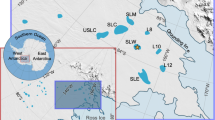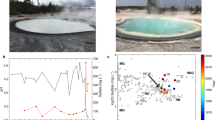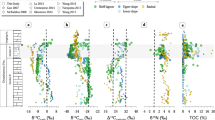Abstract
Substantial parts of the beds of glaciers, ice sheets and ice caps are at the pressure melting point1. The resulting water harbours diverse subglacial microbial ecosystems2,3 capable of affecting global biogeochemical cycles4,5. Such subglacial habitats may have acted as refugia during Neoproterozoic glaciations6. However, it is unclear how life in subglacial environments could be supported during glaciations lasting millions of years because energy from overridden organic carbon would become increasingly depleted7,8. Here we investigate the potential for abiogenic H2 produced during rock comminution to provide a continual source of energy to support subglacial life. We collected a range of silicate rocks representative of subglacial environments in Greenland, Canada, Norway and Antarctica and crushed them with a sledgehammer and ball mill to varying surface areas. Under an inert atmosphere in the laboratory, we added water, and measured H2 production with time. H2 was produced at 0 °C in all silicate–water experiments, probably through the reaction of water with mineral surface silica radicals formed during rock comminution. H2 production increased with increasing temperature or decreasing silicate rock grain size. Sufficient H2 was produced to support previously measured rates of methanogenesis under a Greenland glacier. We conclude that abiogenic H2 generation from glacial bedrock comminution could have supported life and biodiversity in subglacial refugia during past extended global glaciations.
This is a preview of subscription content, access via your institution
Access options
Subscribe to this journal
Receive 12 print issues and online access
$259.00 per year
only $21.58 per issue
Buy this article
- Purchase on Springer Link
- Instant access to full article PDF
Prices may be subject to local taxes which are calculated during checkout



Similar content being viewed by others
Change history
29 October 2015
In the print version of this Letter originally published, the published online date was incorrectly stated as 21 September 2015; the correct published online date is 29 October 2015. This has been corrected in all online versions of the Letter.
References
Bell, R. E. The role of subglacial water in ice-sheet mass balance. Nature Geosci. 1, 297–304 (2008).
Christner, B. C. et al. A microbial ecosystem beneath the West Antarctic ice sheet. Nature 512, 310–313 (2014).
Hamilton, T. L., Peters, J. W., Skidmore, M. L. & Boyd, E. S. Molecular evidence for an active endogenous microbiome beneath glacial ice. ISME J. 7, 1402–1412 (2013).
Wadham, J. L. et al. Potential methane reservoirs beneath Antarctica. Nature 488, 633–637 (2012).
Death, R. et al. Antarctic ice sheet fertilises the Southern Ocean. Biogeosciences 11, 2635–2643 (2014).
Christner, B. C., Skidmore, M. L., Priscu, J. C., Tranter, M. & Foreman, C. M. Psycrophiles: From Biodiversity to Biotechnology Ch. 4 (Springer, 2008).
Moczydlowska, M. The Ediacaran microbiota and the survival of Snowball Earth conditions. Precambr. Res. 167, 1–15 (2008).
Stibal, M. et al. Methanogenic potential of Arctic and Antarctic subglacial environments with contrasting organic carbon sources. Glob. Change Biol. 18, 3332–3345 (2012).
Montross, S. N., Skidmore, M., Tranter, M., Kivimaki, A.-L. & Parkes, R. J. A microbial driver of chemical weathering in glaciated systems. Geology 41, 215–218 (2013).
Hoffman, P. F. & Schrag, D. P. The snowball Earth hypothesis: Testing the limits of global change. Terra Nova 14, 129–155 (2002).
Boyd, E. S., Hamilton, T. L., Havig, J. R., Skidmore, M. L. & Shock, E. L. Chemolithotrophic primary production in a subglacial ecosystem. Appl. Environ. Microbiol. 80, 6146–6153 (2014).
Kelley, D. S. et al. A serpentinite-hosted ecosystem: The lost city hydrothermal field. Science 307, 1428–1434 (2005).
Stevens, T. O. & McKinley, J. P. Lithoautotrophic microbial ecosystems in deep basalt aquifers. Science 270, 450–454 (1995).
Lin, L. H. et al. Radiolytic H2 in continental crust: Nuclear power for deep subsurface microbial communities. Geochem. Geophys. Geosyst. 6, Q07003 (2005).
Kita, I., Matsuo, S. & Wakita, H. H2 generation by reaction between H2O and crushed rock—an experimental study on H2 degassing from the active fault zone. J. Geophys. Res. 87, 789–795 (1982).
Sugisaki, R. et al. Origin of hydrogen and carbon dioxide in fault gases and its relation to fault activity. J. Geology 91, 239–258 (1983).
Fubini, B., Bolis, V., Cavenago, A. & Volante, M. Physicochemical properties of crystalline silica dusts and their possible implication in various biological responses. Scand. J. Work Environ. Health 21, 9–14 (1995).
Konnerup-Madsen, J. & Rosehansen, J. Volatiles associated with alkaline igneous rift activity—fluid inclusions in the Ilimaussaq intrusion and the Gardar granitic complexes (South Greenland). Chem. Geol. 37, 79–93 (1982).
Hallet, B. A theorectical model of glacial abrasion. J. Glaciol. 23, 39–50 (1979).
Zoet, L. K., Alley, R. B., Anandakrishnan, S. & Christianson, K. Accelerated subglacial erosion in response to stick-slip motion. Geology 41, 159–162 (2013).
Hallet, B., Hunter, L. & Bogen, J. Rates of erosion and sediment evacuation by glaciers: A review of field data and their implications. Glob. Planet. Change 12, 213–235 (1996).
Hawkings, J. R. et al. Ice sheets as a significant source of highly reactive nanoparticulate iron to the oceans. Nature Commun. 5, 3929 (2014).
Tranter, M., Skidmore, M. & Wadham, J. Hydrological controls on microbial communities in subglacial environments. Hydrol. Process. 19, 995–998 (2005).
Thauer, R. K., Jungermann, K. & Decker, K. Energy conservation in chemotrophic anaerobic bacteria. Bacteriol. Rev. 41, 100–180 (1977).
Boyd, E. S., Skidmore, M., Mitchell, A. C., Bakermans, C. & Peters, J. W. Methanogenesis in subglacial sediments. Environ. Microbiol. Rep. 2, 685–692 (2010).
Souchez, R. et al. Gas isotopes in ice reveal a vegetated central Greenland during ice sheet invasion. Geophys. Res. Lett. 33, L24503 (2006).
Miteva, V., Teacher, C., Sowers, T. & Brenchley, J. Comparison of the microbial diversity at different depths of the GISP2 Greenland ice core in relationship to deposition climates. Environ. Microbiol. 11, 640–656 (2009).
Christner, B. C., Montross, G. G. & Priscu, J. C. Dissolved gases in frozen basal water from the NGRIP borehole: Implications for biogeochemical processes beneath the Greenland Ice Sheet. Polar Biol. 35, 1735–1741 (2012).
Lovley, D. R. & Goodwin, S. Hydrogen concentrations as an indicator of the predominant terminal electron-accepting reactions in aquatic sediments. Geochim. Cosmochim. Acta 52, 2993–3003 (1988).
Spear, J. R., Walker, J. J., McCollom, T. M. & Pace, N. R. Hydrogen and bioenergetics in the Yellowstone geothermal ecosystem. Proc. Natl Acad. Sci. USA 102, 2555–2560 (2005).
Wiesenburg, D. A. & Guinasso, N. L. Jr Equilibrium solubilities of methane, carbon monoxide, and hydrogen in water and sea water. J. Chem. Eng. Data 24, 356–360 (1979).
Damm, C. & Peukert, W. Kinetics of radical formation during the mechanical activation of quartz. Langmuir 25, 2264–2270 (2009).
Cowton, T., Nienow, P., Bartholomew, I., Sole, A. & Mair, D. Rapid erosion beneath the Greenland ice sheet. Geology 40, 343–346 (2012).
Cowton, T. et al. Evolution of drainage system morphology at a land-terminating Greenlandic outlet glacier. J. Geophys. Res. 118, 29–41 (2013).
Breemer, C. W., Clark, P. U. & Haggerty, R. Modeling the subglacial hydrology of the late Pleistocene Lake Michigan Lobe, Laurentide Ice Sheet. Geol. Soc. Am. Bull. 114, 665–674 (2002).
Souchez, R., Lemmens, M. & Chappellaz, J. Flow-induced mixing in the GRIP basal ice deduced from the CO2 and CH4 records. Geophys. Res. Lett. 22, 41–44 (1995).
Anisimova, M. & Gascuel, O. Approximate likelihood-ratio test for branches: A fast, accurate, and powerful alternative. Systematic Biol. 55, 539–552 (2006).
Anisimova, M., Gil, M., Dufayard, J. F., Dessimoz, C. & Gascuel, O. Survey of branch support methods demonstrates accuracy, power, and robustness of fast likelihood-based approximation schemes. Syst. Biol. 60, 685–699 (2011).
Darriba, D., Taboada, G. L., Doallo, R. & Posada, D. jModelTest 2: More models, new heuristics and parallel computing. Nature Methods 9, 772 (2012).
Boyd, E. S. et al. Diversity, abundance, and potential activity of nitrifying and nitrate-reducing microbial assemblages in a subglacial ecosystem. Appl. Environ. Microbiol. 77, 4778–4787 (2011).
Acknowledgements
The authors acknowledge financial support from an E.U. INTERACT Transnational Access grant (to J.T.), NASA Exobiology and Evolutionary Biology programme (NNX10AT31G to M.L.S. and E.S.B.) and the NASA Astrobiology Institute (NNA15BB02A to E.S.B.).
Author information
Authors and Affiliations
Contributions
J.T. conceived and designed the project. E.S.B. oversaw the microbiological analyses. N.B., E.L.J., G.L.-G., P.G.M. and J.W.M. performed the experiments and geochemical analyses. T.L.H. performed the microbiological experiments and analyses. M.L.S., M.J., D.A.H., E.H. and J.L.W. contributed materials. E.H. assisted on fieldwork. J.T., E.S.B., N.B., M.T., J.L.W. and M.L.S. co-authored the paper.
Corresponding author
Ethics declarations
Competing interests
The authors declare no competing financial interests.
Supplementary information
Supplementary Information
Supplementary Information (PDF 492 kb)
Rights and permissions
About this article
Cite this article
Telling, J., Boyd, E., Bone, N. et al. Rock comminution as a source of hydrogen for subglacial ecosystems. Nature Geosci 8, 851–855 (2015). https://doi.org/10.1038/ngeo2533
Received:
Accepted:
Published:
Issue Date:
DOI: https://doi.org/10.1038/ngeo2533
This article is cited by
-
Mechanochemical processing of silicate rocks to trap CO2
Nature Sustainability (2023)
-
Tectonically-driven oxidant production in the hot biosphere
Nature Communications (2022)
-
Globally elevated chemical weathering rates beneath glaciers
Nature Communications (2022)
-
Glaciers as microbial habitats: current knowledge and implication
Journal of Microbiology (2022)
-
Subglacial erosion has the potential to sustain microbial processes in Subglacial Lake Whillans, Antarctica
Communications Earth & Environment (2021)



